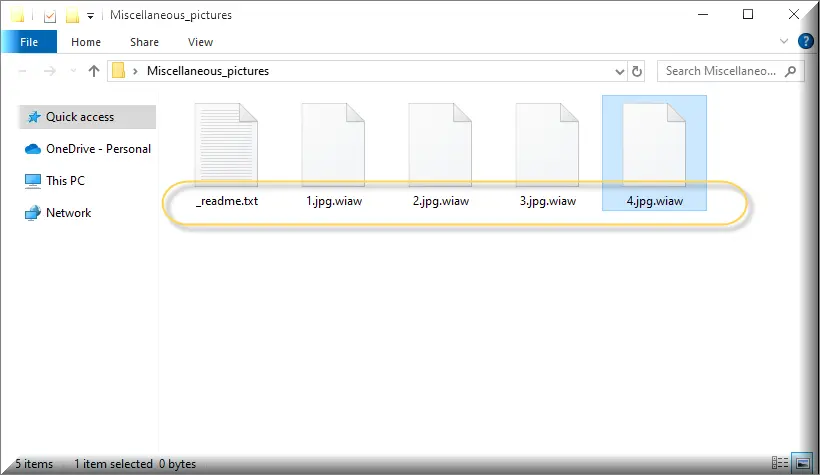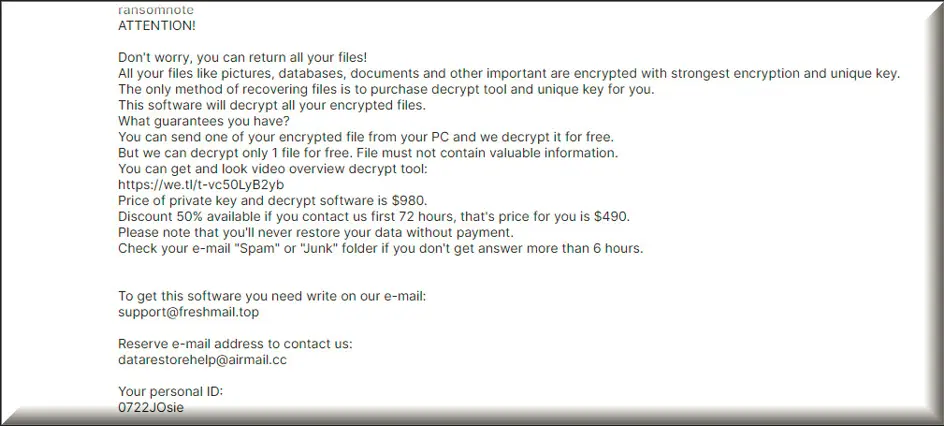
*Wiaw is a variant of Stop/DJVU. Source of claim SH can remove it.
Wiaw File
The Wiaw file encryption is a malicious technique employed by online crooks to take hostage of files on a victim’s PC. The encrypting procedure changes the original files into a ciphered format decipherable only with a special decryption key that is in the possession of the attackers. During the encrypting process, the ransomware restructures the file format, turning it unrecognizable to the system and thus, barring any software or user from accessing the files without the right key. This robust encryption ensures the victim’s inability to open, edit, or regain the Wiaw files unless they yield to the ransom demands. The encryption of files by ransomware is a major menace causing potential data loss, disruption of operations, and financial implications for both individuals and enterprises.

How to decrypt Wiaw ransomware files?
How to remove Wiaw ransomware virus and restore the files?
Wiaw Virus
The Wiaw virus is a ransomware program that encrypts your data, rendering it inaccessible. To regain access to the files that are encrypted, a ransom payment is demanded by the cybercriminals. A special message created by the ransomware informs the victims that their only chance to retrieve their personal files again is by promptly making a ransom payment to a specified cryptocurrency wallet. The operators of the Wiaw, Wisz, Lkhy or Lkfr virus may promise to send you a unique decryption key as soon as they receive the money. However, if you choose to negotiate with them, there’s no guarantee of your computer and files’ future. Hence, instead of risking your system’s safety and the valuable data it stores, we suggest you eliminate the ransomware and explore alternative file recovery methods.

Wiaw
Wiaw is an extortion-oriented virus program that applies encryption to your files, rendering them inaccessible, and then demands you provide a ransom payment for a private decryption key. If the victim doesn’t meet the ransom demands, they’re threatened with the loss of access to their files forever. Numerous concealed delivery mechanisms help the wide distribution of this new ransomware variant, with the majority of infections occurring when users interact with malevolent emails, spam messages, infected attachments, fraudulent ads, or dubious software installers. Upon successfully encrypting the targeted files, the ransomware automatically creates a ransom-demanding notification and positions it on the desktop or within the folders containing the encrypted data.
.Wiaw
Identifying the specific strain of ransomware that has affected your system is of utmost importance when considering potential recovery strategies. In many instances, the ransomware leaves a scary ransom message that details the ransomware type and provides ransom payment instructions. A notable giveaway for identifying the Wiaw ransomware is the .Wiaw file extension appended to the encrypted files. Victims can easily search for the .Wiaw file extension online in order to identify the corresponding ransomware variant. This identification can guide them toward available decryption tools or specialized recovery solutions.
Wiaw Extension
Recovering files secured with the Wiaw extension is not guaranteed and may not always be successful. For this reason, it’s crucial to have a proper understanding of the threat you are dealing with and the related risks. Furthermore, the complexity of the ransomware attacks can differ, meaning that even if one attack’s decryption method is successful, there may be other cases where a completely different decryption approach may be required. So, as you can see, there is no universal solution for ransomware and each and every attack should be handled individually. As far as the Wiaw extension is concerned, we recommend you to approach the ransomware problem armed with a proper removal guide and a trusted antivirus software.
Wiaw Ransomware
Unlocking files affected by the Wiaw ransomware involves reversing the encryption process, which is a step typically only achievable with the corresponding decryption key. To obtain that key for decryption, however, the victims are asked to pay a considerable sum to the hackers. But, sending large amounts of money to anonymous cyber thieves and pinning hopes on their promises is not a viable solution in any scenario. And even though in the case of the Wiaw ransomware attack the options may seem limited, we’ve offered some alternatives for file recovery as well as comprehensive steps on how to remove the infection in the removal guide below.
What is Wiaw File?
The Wiaw file signifies a data file that’s been locked by ransomware but poses no immediate risk or danger to the system where it is stored. This file could be an image, a document, a video, or any other file type that could be found on your computer. The encrypted file is unable to further propagate the ransomware infection or inflict damage on the computer. Instead, it becomes a useless file, held captive by the complex Wiaw file encryption code employed by the Wiaw ransomware. You cannot open or use it with any program and it merely occupies space on the hard drive, awaiting the appropriate decryption solution to liberate it from its encrypted state and restore its initial state.
SUMMARY:
*Wiaw is a variant of Stop/DJVU. Source of claim SH can remove it.
Wiaw Ransomware Removal

Step 1 of this instruction describes how to restart the computer in Safe Mode. Our recommendation is that you begin by clicking on the Safe Mode link and completing the steps there, so that the malware may be removed from your system more easily.
To avoid having to look for Wiaw removal instructions again when you restart your computer, please save this page to your browser’s favorite bookmarks.

WARNING! READ CAREFULLY BEFORE PROCEEDING!
*Wiaw is a variant of Stop/DJVU. Source of claim SH can remove it.
It’s tough to identify ransomware like Wiaw because this danger may lie unnoticed for a long time, and it could do a lot of damage to the system during that time.
One of the most difficult things you’ll have to do when this ransomware infects your computer is discover and stop its malicious processes. To ensure the safety of your computer, please take the time to properly follow the instructions outlined in the next paragraphs.
On your computer’s keypad, simultaneously press CTRL+SHIFT+ESC. To further narrow the scope of your investigation, look for any processes that could be connected to the hazard. Windows Task Manager displays this information on the Processes tab.
Next, look at the files related to any process that look suspicious. The quick menu may be accessed by right-clicking on the suspicious processes and selecting Open File Location.

You may use the free online scanning tool provided below to ensure that the files associated with this process are clean of any possibly dangerous code.

If any of the files are flagged as potentially dangerous, make sure that you first end the running processes related to them by right-clicking on it and selecting End Process. After that, go back to the infected files and delete them from their original locations.
![]()
Aside from ending the malicious processes related to Wiaw, it is equally important to disable any harmful startup items that the malware might have introduced to the system without your knowledge. For this, you need to first open System Configuration and then check the Startup tab.
System Configuration may be found by typing msconfig in the Windows search field. Take a look at the startup items displayed in the Startup tab:

Unchecking any starting items associated with the ransomware should be your first concern. Look for startup components that aren’t generally linked with the apps that run when the system boots up. You can deactivate them by unchecking their checkboxes. Don’t deactivate any operating system or trustworthy program components while doing this, though!
![]()
*Wiaw is a variant of Stop/DJVU. Source of claim SH can remove it.
To guarantee, the ransomware is entirely removed, and no destructive components are left behind, you need to delete any malicious registry entries identified in your registry editor in the fourth step of this guide.
The Registry Editor may be launched by searching for it in the Windows search field and pressing Enter. Search for ransomware-related files in Registry Editor using the CTRL and F keyboard key combination, and type the name of the ransomware in the Find box. Click on Find Next after that to start the search. Right-clicking on a dangerous entry gives you the option to remove it.
Attention! Only the ransomware-related registry entries should be deleted. If you alter the registry or remove anything unrelated to the threat, you may corrupt your system and installed programs, so keep this in mind when you are dealing with the registry files. If you’re still unsure, know that this page has a link to a professional malware cleanup application that can assist you in getting rid of Wiaw and other viruses from your PC.
Close the Registry Editor after you’re done, and then look in the locations listed below for any other possibly malicious files or subfolders. You can search for them in the Windows search field and click Enter to open them one at a time.
- %AppData%
- %LocalAppData%
- %ProgramData%
- %WinDir%
- %Temp%
Any suspicious-looking files or subfolders that have recently been added should be properly checked. Remove any potentially malicious temporary files from your computer by deleting everything in the Temp folder.
The next step is to check your system’s Hosts file for any malicious alterations. Using a Run dialog box (hold down the Windows key and R key at the same time), type the following command in the Run box and then click OK:
notepad %windir%/system32/Drivers/etc/hosts
Please let us know if the Hosts file contains suspicious IP addresses under “Localhost” as seen in the figure below, so that we can investigate further. If you have any questions or concerns, do not hesitate to contact us in the comments.

![]()
How to Decrypt Wiaw files
Dealing with the consequences of a ransomware data encryption can be a challenging task even for professionals. However, it is possible to decrypt data that has been encrypted by using some file-restoration options. The first step, however, is to figure out which type of Ransomware you’re dealing with. It’s easy to find this information by looking at the end of the encrypted files and their file extensions.
New Djvu Ransomware
STOP Djvu is one of the most recent Djvu Ransomware versions that you may encounter and this specific threat can easily be recognized thanks to the .Wiaw file extension that is typically adds to the files that it encrypts.
Those who have had their data encrypted by this new variant may have some hope of recovering it, especially if an offline key has been used to encode their files. This specific ransomware version has a file-decryption program that can assist you decrypt your files. Please click on the link below for more information on how to download it.
https://www.emsisoft.com/ransomware-decryption-tools/stop-djvu
Decryption
Click “Run as Administrator” on the decryption tool file you’ve downloaded, then click “Yes” to run it. Before continuing, please review the provided instructions and the accompanying license agreement. Clicking the Decrypt button will begin the decryption procedure.
Use caution if you need to decode files that has been encoded with unknown offline keys or online encryption, as they may not be decryptable with this program. Please feel free to ask any questions or express any concerns in the comments section below this page.
Important! Be sure to fully scan your computer for ransomware-related files and dangerous registry entries before attempting to decrypt data that has been encrypted. This page’s free online virus scanner and the recommended anti-virus software can both help you eradicate Wiaw-related malware from your computer.

Leave a Reply